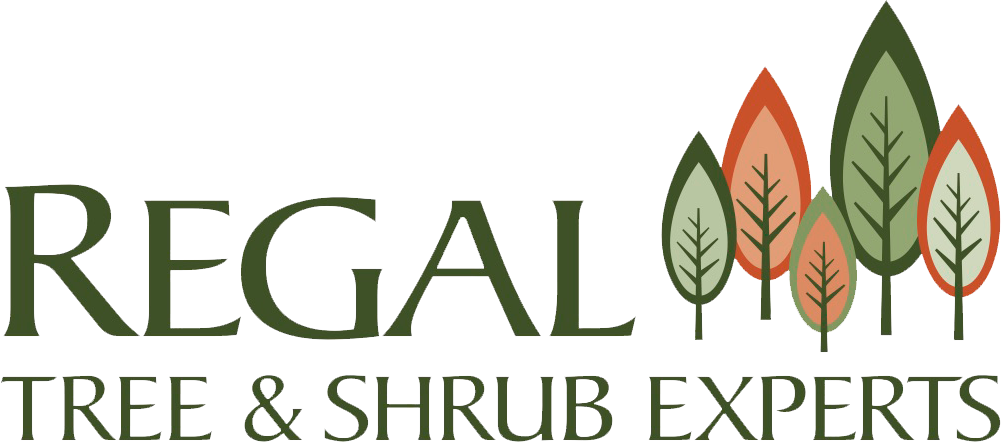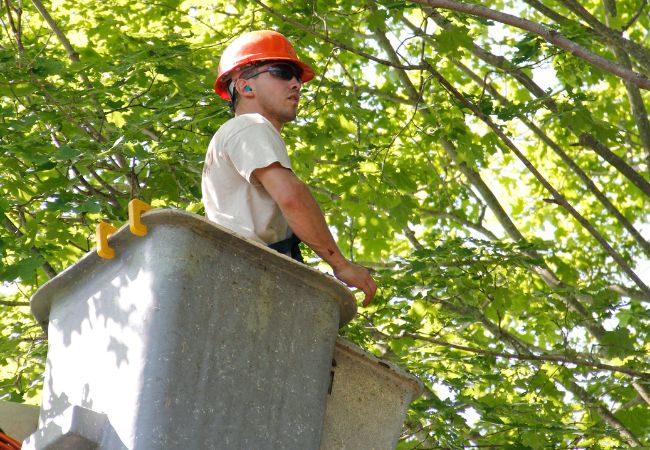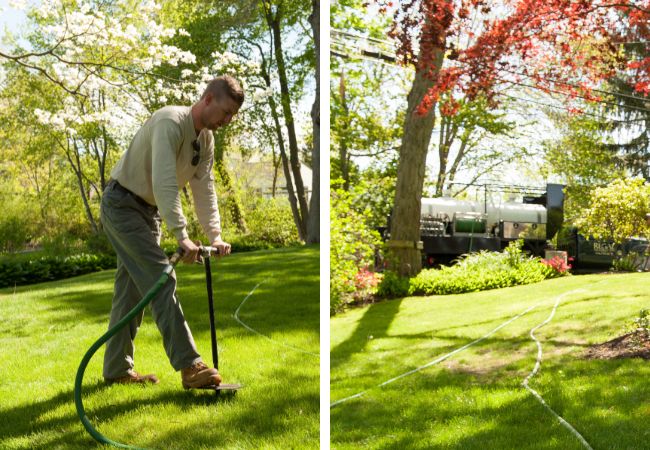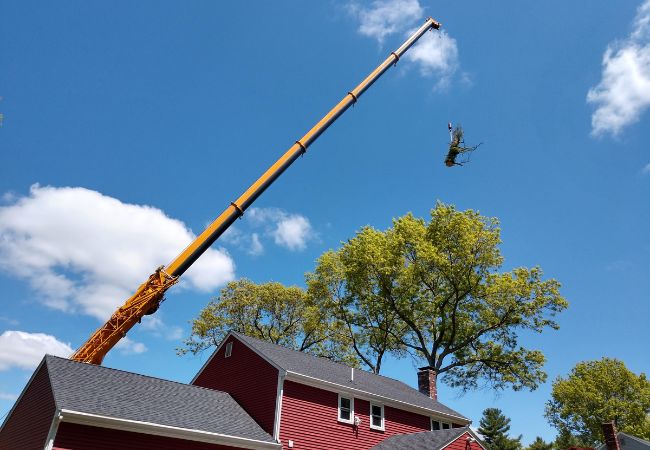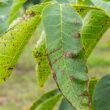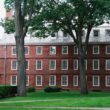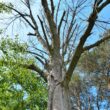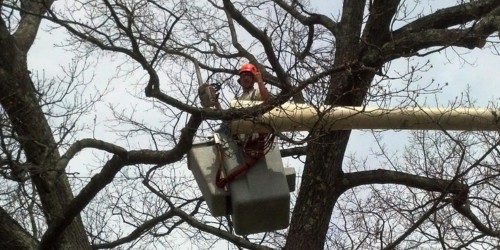Summer can be tough on trees – especially in places like Greater South Easton, where heat, storms, and dry spells aren’t uncommon. If you want your trees to stay healthy through the season, a few simple steps can make a big difference. From watering habits to spotting early signs of stress, here’s what you should be doing for your trees this summer.
Key Takeaways:
- Bristol County has experienced drought and abnormally dry conditions, so trees may need supplemental watering using irrigation systems or soaker hoses to reach deep roots.
- Professional arborists can perform targeted pruning to reduce canopy density, remove weak branches, and improve storm resistance, but avoid over-pruning that stresses trees more.
- Summer is peak season for tree insects and diseases, so look for discolored leaves, premature leaf drop, bark damage, and dead branches that signal the need for professional treatment.
- Get professional soil testing now to identify nutrient deficiencies and schedule fall fertilization, as summer fertilizing can encourage new growth that won’t survive when winter arrives.
- Summer is the best time to identify and remove hazardous trees before severe storms roll in, reducing the risk of property damage or injury.
- Check that mulch is 2-4 inches deep and pulled back from the trunk to help retain moisture and protect roots during hot, dry months.
7 Things to Do for Your Trees This Summer in Greater South Easton
Summer brings challenges for even the healthiest of trees, and while they may not need constant attention, ignoring them could be a costly mistake. Here are seven smart things to do for your trees this season to keep them healthy, safe, and growing strong.
1. Monitor for Drought and Provide Supplemental Water as Needed
Droughts are among the toughest environmental challenges for trees. Without adequate water, they cannot use the nutrients in the ground and convert them into energy to continue growing.
In late fall 2024, Bristol County entered a drought that persisted through most of December. Conditions improved to “abnormally dry” rather than a drought and continued in that status throughout the rest of the winter and into the summer of 2025. Though not as bad as a drought, these conditions can still be stressful for trees.
During a drought, one of the best ways to support your tree is by providing deep, consistent watering. An irrigation system makes this easier by delivering water directly to the root zone. If that’s not an option, a soaker hose is a great alternative – it releases water slowly, allowing moisture to soak deep into the soil where your tree needs it most.
2. Have a Professional Perform Light Pruning
While winter is often the best time to do significant trimming of your tree for beauty and health, summer has advantages as well. In the summer, you’ll be able to see the tree fully leafed out and get an idea of its size and canopy density.
With this knowledge, a professional arborist can perform targeted pruning to remove select branches to reduce canopy density or make your tree more compact. An overly dense canopy can make your tree’s interior humid and encourage mold and fungi development. It will also have competing branches that can rub against each other and remove the outer bark, opening them up to insect attacks.
Summer pruning also makes your trees more storm-resistant by removing broken or weak branches more likely to break off when the winds pick up.
If you do any trimming in the summer, keep it light and focused. One of the biggest pruning mistakes homeowners make in Greater South Easton is trimming too much in the summer. Over-pruning in the summer can lead to excessive stress for your trees, providing insects with an opportunity to attack.
3. Watch for Symptoms of Insects and Diseases
Summer is the season when tree insects and diseases are most active and prone to cause damage to your trees. Scheduling preventive treatments and keeping an eye out for any early warning signs of an infection can be the difference between your tree living and dying. Though different diseases and insects will produce various symptoms, some common ones to look for include:
- Discolored leaves
- Premature leaf drop
- Leaf damage
- Holes and damage in the bark
- Dead branches
If you see any of these signs, it’s likely an indication that you need to call an arborist and have them take a closer look at your trees. They will inspect your trees and diagnose if they are dealing with insects and diseases. If they are, they can suggest tree preservation methods to help them recover.
4. Get a Professional Soil Test and Schedule Fall Fertilization
Soil in your yard will eventually be depleted of nutrients as your trees grow. In a forest, fallen leaves and branches will eventually decompose and add nutrients to the soil. However, raking them up in the fall denies your trees easy access to decomposing organic matter.
Fertilization can supplement the nutrients in the soil and help your tree continue to grow. However, it should always target a nutrient deficiency. Many homeowners opt for a general application that may provide too much nitrogen.
Before fertilization, have a professional conduct a soil test. While you may be able to find soil testing kits at your local store, they are often cheap and unreliable. To ensure accurate results, send a sample to the University of Massachusetts for soil testing.
Once you have your results, talk to a professional tree service about scheduling fall fertilization. Fertilizing in the summer can encourage too much growth that won’t survive the winter. But by getting your soil test and getting on the schedule now, you can ensure you’ll be able to get your trees the nutrients they need in the fall.
5. Add Organic Mulch Around Your Trees
Placing organic mulch around your tree (such as wood chips) has numerous benefits for your trees, including adding organic matter to the soil and helping retain moisture during a drought. However, mulch only helps when you apply it correctly.
The summer is the perfect time to inspect your mulch and ensure it still serves its purpose. There are two main things you should look at this summer:
- Mulch Depth: Ideally, your mulch should be between 2 and 4 inches deep. Putting too much mulch around your tree will suffocate the roots and stop them from getting enough water and oxygen. Putting too little will limit the benefits your trees receive from the mulch.
- Mulch Position: If possible, extend your mulch layer to the edge of a tree’s drip line (the portion under the canopy). Additionally, mulch should not touch the root flare (the part where the trunk meets the roots). Piling it up around the root flare will potentially cause rot and encourage the development of fungi.
6. Schedule Tree Removal for At-Risk Trees
When you notice a tree showing signs of being potentially hazardous, you need professional removal as soon as possible. Summer storms can knock these trees over, causing damage to your property and potentially injuring someone.
Summer is a great time to remove a tree because it is easier to tell its condition and determine if removal is the only answer. Summer is also great for limiting collateral damage to your yard during tree removal, especially when dry.
7. Hire an Arborist for a Tree Inventory on Your Commercial Property
Whether you own a business or are on the board for a condo or HOA, you probably have a lot on your plate. To help take worrying about trees off the list, consider having a professional company perform a tree inventory.
A tree inventory will give you a documented list of the trees on your property, along with information on their condition, size, and possible future problems. This will allow you to make a complete budget for future tree care.
Frequently Asked Questions About Summer Tree Care
Summer is a busy time for tree services, and it should be a busy time for homeowners to take care of their trees. We’ve answered some common questions about summer tree care to help you understand what you need to do for your property and why.
Why is summer a stressful time for trees?
Summer is stressful for trees because they face numerous threats, from pests to drought and heat. While healthy trees can get through the season with little intervention, already stressed trees will struggle to get through a harsh summer. And insects are more likely to target stressed trees than healthy ones.
Can I plant trees in the summer?
We recommend waiting to plant trees until the fall, rather than planting them in the summer. Fall planting gives your tree the most time to establish itself before it has to face the often harsh summer conditions.
Should I prune my trees after a summer storm?
Yes, we recommend pruning a tree after a storm if there is significant damage to the tree. Have a professional trim any broken branches and work to help your tree recover with restoration pruning.
Are Your Trees Struggling This Summer? Regal Tree Can Help!
Summer tree care can often feel daunting, especially if you have a busy summer full of plans. When you need help with the most complex parts of tree care, like pruning or treating for insects and diseases, you need help from the professional team at Regal Tree.
Every job is handled by professionals with the training and experience to do it right. We can diagnose what’s wrong with your trees and help you check items off your summer tree care checklist. Call us today at 774-719-2450 or request a quote online.
